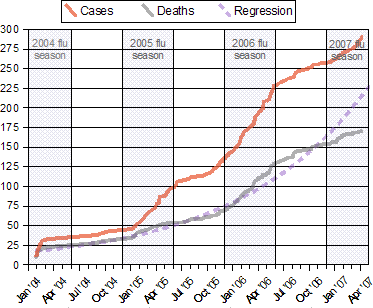Global spread of H5N1 in 2004
 |
The global spread of (highly pathogenic) H5N1 in birds is considered a significant pandemic threat.
While prior
H5N1 strains have been known, they were significantly different from the current H5N1 strain on a genetic level, making the global spread of this new strain unprecedented. The current H5N1 strain is a fast-mutating, highly pathogenic avian influenza
virus (HPAI) found in multiple bird species. It is both epizootic (an epidemic in non-humans) and panzootic (a disease affecting animals of many species especially over a wide area). Unless otherwise indicated, "H5N1" in this article refers to the recent highly pathogenic strain of H5N1.
H5N1 caused
flu outbreaks in 1959 and in 1991 but these strains were very different from the current highly pathogenic strain of H5N1. Evolution
from 1999 to 2002 created the Z genotype which became the dominant strain of highly pathogenic H5N1 in 2004.
In January 2004 a major new outbreak of
pigeons, and other birds and that it was increasing its ability to infect mammals as well. From this point on, avian influenza
experts increasingly refer to containment as a strategy that can delay but not prevent a future avian flu pandemic.
January
 Notes:
|
- A major new outbreak of H5N1 surfaced in geese (over forty million chickens alone were slaughtered in high-infection areas), and the outbreak was contained by March, but the total human death toll in Vietnam and Thailand was twenty three people.[citation needed]
February
- "The Ministry of Public Health in Thailand has confirmed the country's tenth case of H5N1 infection."[1]
July
- Fresh outbreaks in poultry were confirmed in China. Research identifies the dominant strain of H5N1 as the "Z genotype".
August
- Avian flu was confirmed in Kampung Pasir, OIE declare Malaysian poultry bird flu free.[2]
September
October
- Researchers discover H5N1 is far more dangerous than previously believed. "In the past, outbreaks of highly pathogenic avian influenza in poultry began following the primary introduction of a virus, of low pathogenicity, probably carried by a wild bird. The virus then required several months of circulation in domestic poultry in order to mutate from a form causing very mild disease to a form causing highly pathogenic disease, with a mortality approaching 100%. Only viruses of the H5 and H7 subtypes are capable of mutating to cause highly pathogenic disease. In the present outbreaks, however, asymptomatic domestic ducks can directly introduce the virus, in its highly pathogenic form, to poultry flocks."pigeons, and other birds and that it was increasing its ability to infect mammals as well. From this point on, avian influenza experts increasingly refer to containment as a strategy that can delay but not prevent a future avian flu pandemic.[citation needed]
November
- The U.S.'s National Institutes of Health's (NIH) National Institute of Allergy and Infectious Diseases's (NIAID) Influenza Genome Sequencing Project to provide complete sequence data for selected human and avian influenza isolates begins.[5]
December
- "[F]irst human case of H5N1 [is] detected in Vietnam since early September".[6]
See also
References
- ^ WHO (February 27, 2004). "Situation (human) in Thailand". Disease Outbreak News: Avian Influenza A(H5N1). 30. Archived from the original on March 7, 2004.
- ^ "Malaysia wants its poultry declared bird flu-free". Reuters. September 21, 2005.
- ^ WHO (September 28, 2004). "Situation in Thailand, Update 2". Disease Outbreak News: Avian Influenza A(H5N1). Archived from the original on October 7, 2004.
- ^ WHO (October 29, 2004). "Situation in Asia: altered role of domestic ducks". Disease Outbreak News: Avian Influenza A(H5N1). Archived from the original on November 10, 2004.
- S2CID 588711.
- ^ WHO (December 30, 2004). "Situation in Viet Nam". Disease Outbreak News: Avian Influenza A(H5N1). Archived from the original on January 5, 2005.
